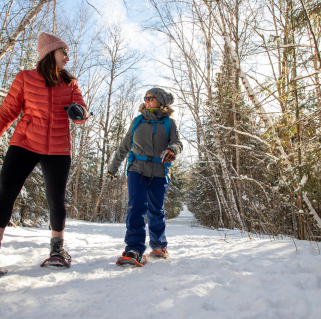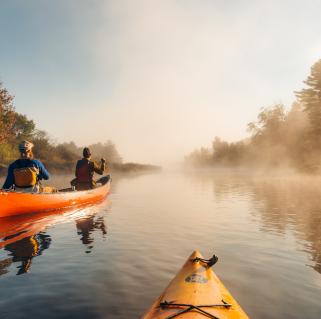Alan Belford
July 24, 2014
One of the many professional hats I wear finds me teaching Field Ornithology courses at Cranberry Lake Biological Station for the State University of New York. The other week I was teaching the Ornithology portion of a Wildlife Techniques class, and the students and I were to be seen traipsing around various habitats in the Adirondacks and North Country.
On one day we headed out through Lake Placid to Whiteface Mountain where we could discuss bird species found in spruce-fir forests near the summit. After stopping briefly so the students could enjoy the ski jumps in Lake Placid we wound up through the impressive cliffs of Wilmington Notch and stopped to admire the sheer rock faces. A few birds were singing such as Northern Parula, Cedar Waxwing, and American Redstart, but it was difficult to do birding by ear with the noise of the AuSable River and the passing of occasional cars. We watched an Osprey flying along the river away from its nest sitting at the top of a dead snag, and I began discussing a bit about Peregrine Falcon conservation and their use of the cliff faces for nesting. We scanned the cliffs to see if we could get lucky and find a falcon, but didn’t note anything.
Then a student drew my attention to what she thought might be a nest on the cliff, and while what she noticed didn’t appear to be a nest, I suddenly found a falcon flying! With some effort we directed everyone to see the bird and we followed it out and back from the distant cliffs, hoping to nail down where a potential nest might be lodged. We didn’t succeed in that endeavor and after several minutes the falcon flew up and over the cliff and out of sight.
We moved on up the mountain, stopping to get our permit as an educational group at the bottom. The mountain was officially closed that day as road crews were improving the driving surface, but we had permission to head up.
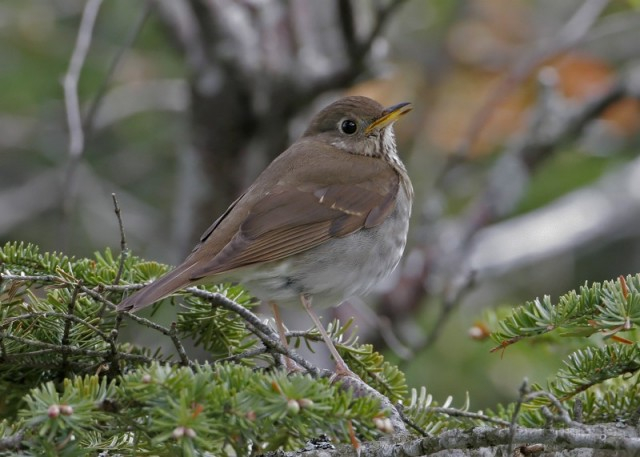
One of the incredible things about driving Whiteface is that is gives visitors the chance to see the transformation in habitats with increasing elevation. We stopped off at a few pull-offs to note this change in vegetation and found bird species like Black-throated Green Warbler, Red-eyed Vireo, and Blue-headed Vireo towards the bottom. Then we moved up slope commenting on how the habitat and its bird community changed.
We stopped just below the Lake Placid curve and the student who was driving the second van commented that her vehicle had difficulty in getting started at our last stop. “I guess we’ll see how it does this time,” we thought, and we set to discussing birds of alpine habitats and their conservation as Swainson’s Thrushes, a Winter Wren, and a Blackpoll Warbler sang.
As we stood there a Black-backed Woodpecker called and flew across the road in plain view! Black-backeds are more common in lowland bogs and boreal forests. We loaded up for the Lake Placid curve and tried the van. It cranked. It sputtered. It had plenty of battery power. But it would not start. It seemed to not be receiving any gas. After trying a few more times and a trying few tricks to see if we could get it fuel, we gave up. “This looks like a good place for lunch,” I said, as I set to work making phone calls to figure out what to do with a broken down van and how to get us off the mountain (the van I was driving was not large enough for all of us).

And it was a beautiful spot for lunch. Storms were predicted that day and building clouds threatened our dry security, but as we ate the clouds swept up and over the peak, often obscuring it, but at other times revealing the summit and the castle swirled in mist. The view below us of the Union Falls and Franklin Falls area was generally open as clouds raced across the landscape, and the students took advantage of our plight by snapping photos.
The birds too were cooperative. We were well above the 3300 foot elevation we use to mark the beginning of suitable Bicknell’s Thrush habitat and after several minutes a Bicknell’s began to call. Then a second. Then a third. Dark-eyed Juncos, Yellow-rumped Warblers, the Winter Wren, and Swainson’s Thrushes continued to sing as well. Soon a Nashville Warbler joined them and the Blackpoll Warbler, which had been singing the entire time out of view, eventually came into view several times for everyone to see while we were stranded. With all this and a Black-backed Woodpecker we had found everything we were hoping for – of all the places to break down, it really was a great one!
Eventually a friend of mine arrived from Saranac Lake to rescue us and after a few hours on the mountain we were able to make our way down. We headed to my place where we met up with a van being driven out from campus. The maintenance workers who dropped off the new van then headed out to pick up the abandoned van with a large trailer. We headed back to campus, arriving just in time for dinner to begin and not long before the skies opened up with torrential downpours and thunderstorms. Glad we weren’t on the mountain for that.
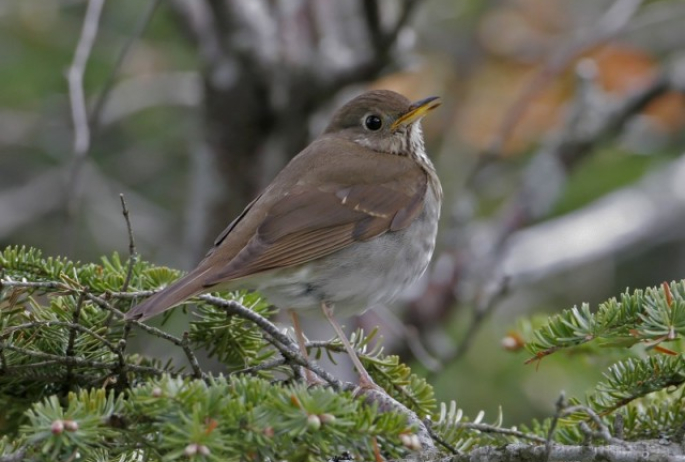
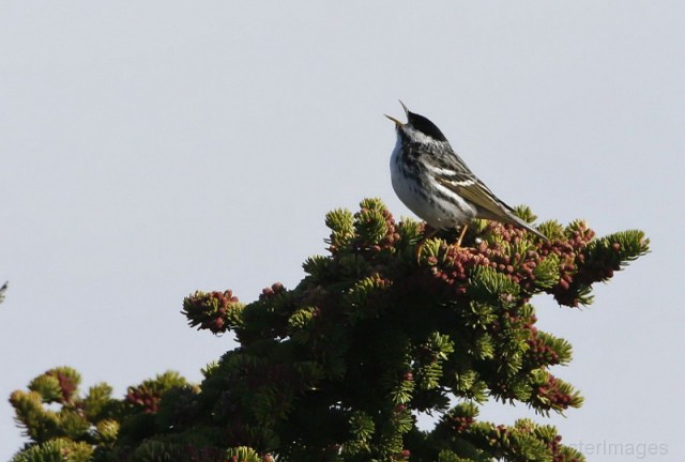
Packages and Promotions
Valid Jan. 21
- Jan. 21
Valid Jan. 21
- Jan. 21
Pet Getaway
Voco Saranac Lake
Your dog deserves an Adirondack getaway too. Book our pet friendly hotel near Lake Placid welcomes every member of your crew. Book our Pet Package...
Valid Dec. 1
- Dec. 1
Valid Dec. 1
- Dec. 1
Linger Longer in Saranac Lake
Best Western Saranac Lake
Linger Longer in Saranac Lake at our supremely located property, Best Western Saranac Lake. Stay 2 nights or more and get 15% off!
Valid Jan. 16
- Mar. 31
Valid Jan. 16
- Mar. 31
Hotel Saranac Sled & Spoke Package
Hotel Saranac
Snowmobile Package Hotel Saranac and Sara-Placid Sled & Spoke have partnered so you and a guest can explore dozens of miles of ADK snowmobile...
Valid Jan. 21
- Jan. 21
Valid Jan. 21
- Jan. 21
Stay and Dine
Voco Saranac Lake
Receive a 50 dollar credit per stay to use in our Boathouse Saranac Lake Pub. Enjoy an exceptional dining experience with unparalleled views great...
Valid Jan. 16
- Mar. 31
Valid Jan. 16
- Mar. 31
Hotel Saranac Ski & Stay Package
Hotel Saranac
Stay & Ski Package Stay at Hotel Saranac and Ski Titus Mountain Day or Night Package Your room reservation includes one adult lift ticket....
Valid Jan. 21
- Mar. 31
Valid Jan. 21
- Mar. 31
Titus Mountain Ski Package
Voco Saranac Lake
Enjoy your stay at the award winning voco Saranac Lake which includes two adult lift tickets at Titus Mountain Family Ski Center. Additional...
Valid May. 1
- Oct. 31
Valid Dec. 6
- Nov. 1
Zip and Whip Expedition
Farmhouse UTVs
Experience Outdoors and Farmhouse UTVs have teamed up to bring your family and friends the Adirondack adventure you've been waiting for....
Valid Jun. 20
- Sep. 7
Valid Mar. 12
- Jun. 30
Guided Nature Immersions - 10% off for Pre-Season Registration
Adirondack Riverwalking & Forest Bathing
Picture it now...you are wading the Ausable River on a warm summer day, feel the cool water against you, hear the sounds of the birds and the...

